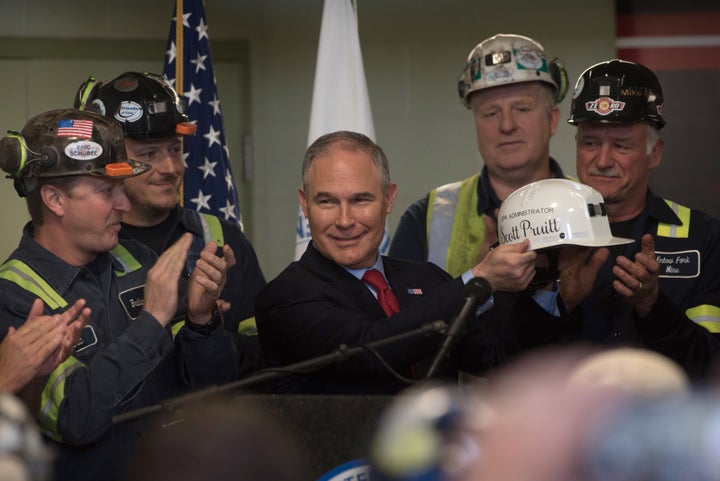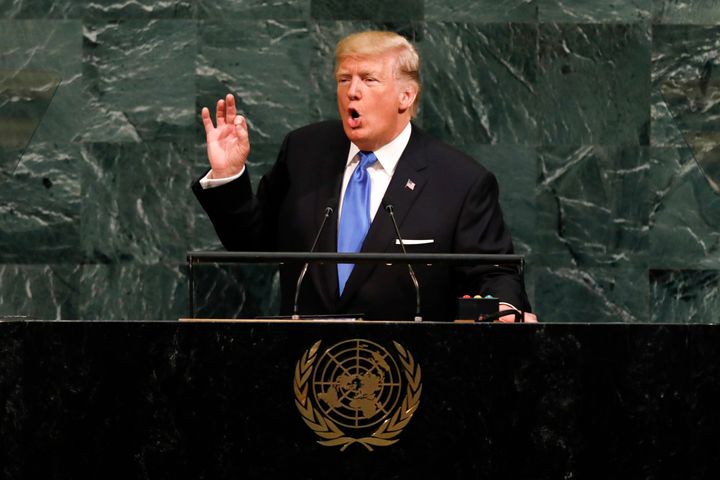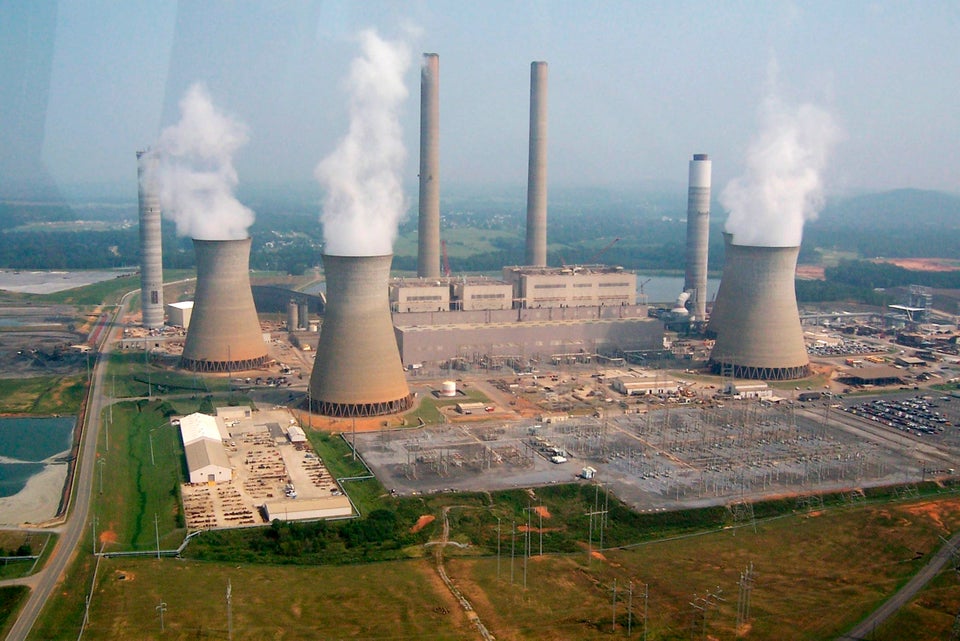Environmental Protection Agency Administrator Scott Pruitt’s tense look broke into a toothy grin at the end of a 22-minute interview with Time Magazine when the reporter called his response to a question “good, but lawyerly.”
“Lawyerly, huh?” the former Oklahoma attorney general said. He furrowed his brow for two seconds, then began to chuckle. “Well, really? Well, thank you!”
The interview ― one of only a few granted by Pruitt to a mainstream media outlet in recent months ― focused largely on his proposal last week to scrap the Clean Power Plan, a set of Obama-era regulations aimed at reducing carbon emissions from electrical utilities. Pruitt has served as the speartip of President Donald Trump’s deregulatory agenda, helping to eliminate or review most of the 52 environmental rules the administration has tackled since taking office.
“We’ve achieved a lot with the president’s leadership,” Pruitt said.
He also seems to have adopted this president’s characteristic disregard for facts. Here are eight assertions he made during the interview that don’t add up.

1. “I don’t spend any time with polluters.”
During his first few months in office, Pruitt spent more time meeting with fossil fuel executives than environmental and public health advocates, calendars released in June under a Freedom of Information Act request showed. Since then, he’s spent less than 1 percent of his time with environmentalists. To argue, as Pruitt later did, that fossil fuel companies don’t pollute is to ignore the 2007 U.S. Supreme Court ruling that found that carbon dioxide posed a threat to human health, to say nothing of the millions of barrels of oil spilled per year. Just last week, an underwater pipeline burst in the Gulf of Mexico, spewing what may be the largest leak of oil in the region since the 2010 Deepwater Horizon BP oil spill.
2. “I prosecute polluters.”
Pruitt said this just moments later. While it’s technically true, it obscures the fact that prosecutions of polluters are way down. The Trump administration’s Justice Department collected 60 percent less in civil penalties from polluters than the past three administrations over the same period, according to an analysis released in August by the Environmental Integrity Project.
At the EPA, the amount of money charged in “injunctive relief” ― how much violators are expected to spend to install and maintain new equipment needed to clean up pollution or comply with environmental standards ― has plummeted. By the end of July, the Trump administration estimated that injunctive relief required in 10 cases reporting such data would total $197 million, compared with $710 million in 16 cases under President George W. Bush and more than $1.2 billion in 22 cases under President Barack Obama during the same amount of time. The EPA did not begin compiling this data until the late 1990s, the report said, so comparable estimates were not available for the Clinton administration’s first year.
3. “The Clean Power Plan rule is deficient because it’s been questioned by the U.S. Supreme Court and the stay has been issued.”
The Supreme Court decided in February 2016 to intervene to halt the implementation of the Clean Power Plan following what the Obama EPA called “extraordinary and unprecedented” requests for a stay. Pruitt, then Oklahoma’s attorney general, led that charge after the U.S. Court of Appeals for the District of Columbia Circuit unanimously refused to grant a stay a month earlier. The Clean Power Plan’s legality rests on the argument that the EPA has authority to regulate greenhouse gases under Section 111 of the Clean Air Act. The Supreme Court’s five conservative justices questioned whether that was the case and therefore temporarily blocked the Clean Power Plan but did not rule as to whether that interpretation is wrong. Repealing the Clean Power Plan before this question can be settled is a procedural decision that demonstrates Pruitt’s belief that the rule is not constitutional and so must be eliminated, but the court simply ruled that the legality had yet to be determined.

4. The creation of the endangerment finding “happened in months … this agency doesn’t build a record within months with respect to these kinds of issues.”
First, some background: In 2007, the Supreme Court found that the EPA is obligated to regulate any type of air pollution that “may reasonably be anticipated to endanger public health or welfare” under the 1970 Clean Air Act. The Bush administration’s EPA determined that greenhouse gases were, in fact, a danger but decided not to do anything about it. The Obama administration’s EPA took the issue up shortly after taking office and, in December 2009, issued its conclusion, commonly called the endangerment finding, which compelled the agency to start regulating those emissions. That finding forms the basis of regulations to reduce emissions, such as the Clean Power Plan, and cannot be overturned unless Pruitt could prove in court that greenhouse gases don’t cause climate change.
But, back to his point, to say that the endangerment finding was crafted in mere months is demonstrably untrue.
5. The endangerment finding is based on the U.N. Intergovernmental Panel on Climate Change.
During the interview, Pruitt said the finding “represents, and this is the first time in history this has ever occurred, this agency took work product of the U.N. Intergovernmental Panel on Climate Change and adopted it, transferred it to this agency and used that as the basis, underpinnings, of the endangerment finding.”
That claim appears to be a dog whistle to nationalists, suggesting the legal mandate for the federal government to address climate change is rooted in fulfilling some demand from an international body.
The technical support document on the endangerment finding references more than 100 published scientific studies and cites peer-reviewed syntheses of climate research by the White House’s U.S. Global Change Research Program, the National Research Council of the U.S. National Academy of Sciences and the IPCC, according to the Environmental Defense Fund.

6. A red-team, blue-team debate on climate change will foster a “robust, meaningful discussion.”
The science behind human-caused global warming is largely settled, despite what so-called skeptics like Pruitt argue. Only 3 percent of peer-reviewed scientists have found that climate change is either not a risk or not exacerbated by humans. And a research review published last November found flaws in the methodologies, assumptions or analyses used in those studies that, when corrected, put their findings in line with the 97 percent of scientists who say climate change is a major, manmade threat.
Yet Pruitt said in June he plans to assemble a red team and a blue team to debate the merits of climate science.
“That’s actually an exercise that was used during the 1970s into the ’80s in the intelligence community to assess the Soviet threat and to help formulate the response to the Soviet threat,” he said in the Time interview. “This is a robust, meaningful debate, discussions, about what do we know and what don’t we know, and let the American people be consumers of that, so that we might be able to see consensus around this issue.”
Yet the premise here is based on the idea that the peer-reviewed process that every major scientific paper on climate change has already gone through is somehow flawed. And giving equal weight to skeptics of the existing consensus skews Americans’ perception of the scientific findings, according to U.S. National Academy of Sciences atmospheric scientist Benjamin Santer, MIT atmospheric science professor Kerry Emanuel and Harvard history of science professor Naomi Oreskes.
“Such calls for special teams of investigators are not about honest scientific debate,” the trio wrote in The Washington Post in June. “They are dangerous attempts to elevate the status of minority opinions, and to undercut the legitimacy, objectivity and transparency of existing climate science.”
7. “The states, they’ve been very, very thankful that we’ve engaged with them and been proactive in how we do work together to achieve good environmental outcomes, and also see economic progress. That’s not something that should be taken for granted, because it didn’t happen in the past administration.”
In August, 16 states sued the EPA to stop Pruitt from delaying the implementation of a smog rule. Last week, hours after Pruitt announced his proposal to scrap the Clean Power Plan, New York Attorney General Eric Schneiderman said he’d sue to defend the regulations against the Trump administration’s “persistent and indefensible denial of climate change.” Massachusetts Attorney General Maura Healey also said she would sue. On Friday, Trump forced Pruitt to backtrack on proposed changes to the nation’s biofuels policy after lawmakers in corn states such as Iowa, Nebraska and Illinois protested over concerns that the new rules would hurt demand for ethanol.
Yet the real bogus claim here is that the Obama administration didn’t engage with the states affected by its regulations.
Just consider North Dakota. In 2014, then EPA chief Gina McCarthy visited the oil-producing state as a “listener and a saleswoman,” saying she had to be “everywhere” because “people have to have a relationship with me.” Months later, then-Energy Secretary Ernest Moniz toured the state and held public talks about future policy and the quivering price of Bakken crude oil. Unlike Pruitt, who toured the state but kept out local journalists, those officials made themselves accessible to the public.

